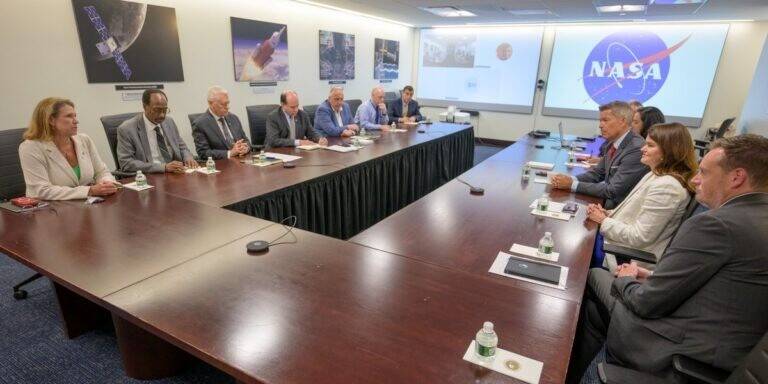NASA is bracing for a critical transition after concluding a voluntary workforce reduction initiative aimed at aligning with the Trump Administration’s proposed budget cuts. The agency confirmed late Friday that more than 3,000 employees—roughly 21 percent of its civil service workforce—have opted to leave through various voluntary exit programs, raising serious concerns across Congress and the aerospace community about the agency’s capacity to deliver on its missions.

NASA Interim/Acting Administrator and Secretary of Transportation Sean Duffy (third on right, red tie) meets with top NASA managers, July 18, 2025. Source: @SecDuffyNASA on X
The options for employees to voluntarily depart—through the Deferred Resignation Program (DRP), the Voluntary Early Retirement Authority (VERA), or the Voluntary Separation Incentive Program (VSIP)—closed at 11:59 p.m. EDT on Friday. While some will leave by September 30, the end of fiscal year 2025, others may remain until early 2026 depending on the terms of their program.
NASA estimates that after normal attrition and the voluntary departures, its civil servant headcount will drop from 17,391 to approximately 14,000—still short of the administration’s target of 11,853 employees for FY2026. Involuntary layoffs, known as Reductions-in-Force (RIFs), may still follow.
The agency said in a late-night statement, “Safety remains a top priority for our agency as we balance the need to become a more streamlined and more efficient organization and work to ensure we remain fully capable of pursuing a Golden Era of exploration and innovation, including to the Moon and Mars.”
The Trump Administration’s FY2026 budget proposal seeks to slash NASA’s funding by $6 billion—from $24.8 billion this year to $18.8 billion next year. However, Congress appears unlikely to go along. Both the House and Senate appropriations committees support maintaining NASA’s current funding levels, and a reconciliation bill signed into law by President Trump on July 4 includes an additional $10 billion for NASA over several years.
Nevertheless, the workforce reduction is moving forward before Congress finalizes appropriations, raising alarms among lawmakers and within NASA itself.
A growing chorus of concern is emerging from within the agency. In a formal letter of dissent—known as the NASA Voyager Declaration—more than 300 current and former employees warned that the non-strategic downsizing could severely undermine NASA’s core mission.
“We dissent to NASA’s non-strategic staffing reductions because they will jeopardize NASA’s core mission,” the declaration reads. “Thousands of NASA civil servant employees have already been terminated, resigned, or retired early, taking with them highly specialized, irreplaceable knowledge crucial to carrying out NASA’s mission.”
The dissent also flagged concerns about changes to NASA’s safety authority and premature termination of missions without congressional review.
Lawmakers have taken notice. On July 18, more than 60 bipartisan House members led by Rep. Valerie Foushee (D-N.C.), Ranking Member of the House Science, Space, and Technology Committee’s space subcommittee, sent a letter to Interim NASA Administrator Sean Duffy urging the agency to halt actions based on the President’s budget until Congress formally approves it.
“We write to ensure no actions are taken at NASA to implement the proposed funding cuts... or otherwise preclude the continuation of NASA’s science programs,” the letter stated.
At a National Academies joint board meeting last week, Democratic and Republican congressional staffers expressed deep concern about the potential mismatch between congressional intent and NASA’s operational capacity.
“If we get an appropriation… what does it mean to have thousands of people having left the agency? A lot of them GS-15s who have extensive experience and knowledge,” asked Pam Whitney from the Democratic staff of the House Science Committee.
Republican Senate Commerce Committee staffer Maddy Davis echoed the concern: “We have big, bold, audacious goals. NASA always has… but we are very concerned about the DRP’s impact.”
JPL and Other Agencies Also Impacted
The downsizing does not include staff at NASA’s Jet Propulsion Laboratory (JPL) in Pasadena, California, which is managed by Caltech. JPL has already conducted two rounds of layoffs—8 percent in February 2024 and another 5 percent in November—primarily due to the suspension of the Mars Sample Return mission.
NASA is not alone. Other U.S. science agencies, including the National Oceanic and Atmospheric Administration (NOAA), National Science Foundation (NSF), and National Institutes of Health (NIH), are facing similar workforce losses due to federal cutbacks.
The Aerospace Industries Association has also voiced concern. In a May 30 letter to congressional appropriators, the group warned that workforce reductions and budget cuts could drive U.S. talent overseas and jeopardize thousands of high-skill jobs.
What Comes Next?
Janet Petro, who served as Acting NASA Administrator earlier this year, attempted to minimize involuntary departures during her tenure. So far, only 23 civil servants have been forcibly removed. At a June 27 town hall, Petro urged employees to reflect carefully before choosing to leave and emphasized that preserving talent was a priority.
Still, with the voluntary programs concluded, uncertainty lingers. The final number of departures remains fluid as employees can still withdraw, and not all resignations have been approved. The full impact of these reductions may not be clear until early 2026.
As Congress weighs NASA’s funding future, a fundamental question remains: can the agency continue to deliver on its ambitious goals with a significantly reduced—and potentially hollowed out—workforce?
For now, NASA stands at a pivotal moment, balancing ambition against attrition as it tries to chart a sustainable path to the Moon, Mars, and beyond.


Add comment
Comments